Financial Accounting Report: Performance Analysis of Tesco plc
VerifiedAdded on 2023/06/17
|9
|2022
|406
Report
AI Summary
This report provides a financial analysis of Tesco plc from 2017 to 2020, evaluating its performance, liquidity, and financial structure using various accounting ratios. The analysis reveals volatility in profitability ratios, with revenue showing a positive trend. Operational ratios indicate competitiveness, while liquidity ratios suggest a need for adjustments to address commitments. The report also highlights limitations in using accounting ratios, including changes in accounting standards, reliance on historical data, and potential for personal bias. Ultimately, the report emphasizes the importance of financial accounting for achieving company goals but notes the need for improvements in various departments for Tesco to maintain a market-leading position. It concludes that the company's accounting condition is poor and needs statistical information for improvements.
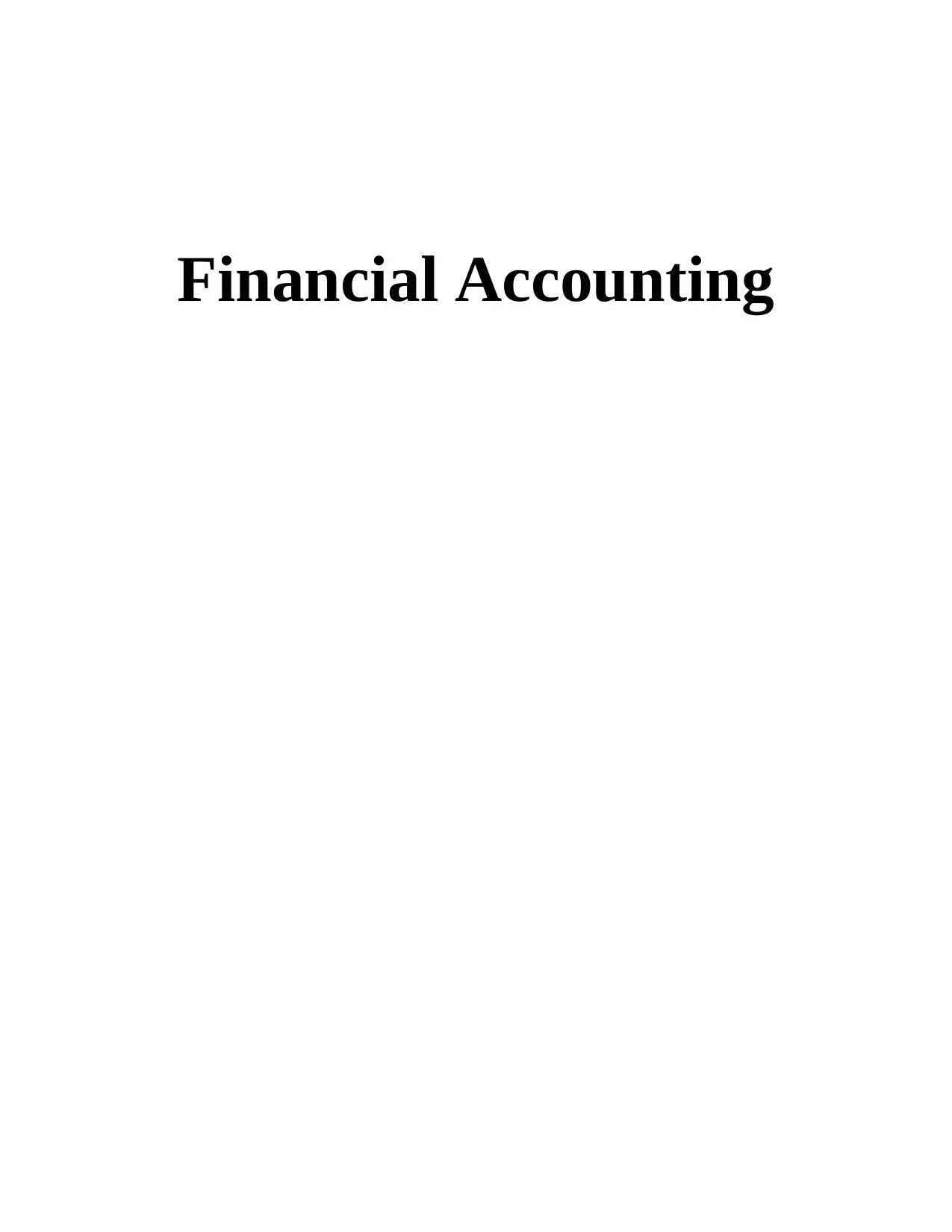
Financial Accounting
Paraphrase This Document
Need a fresh take? Get an instant paraphrase of this document with our AI Paraphraser

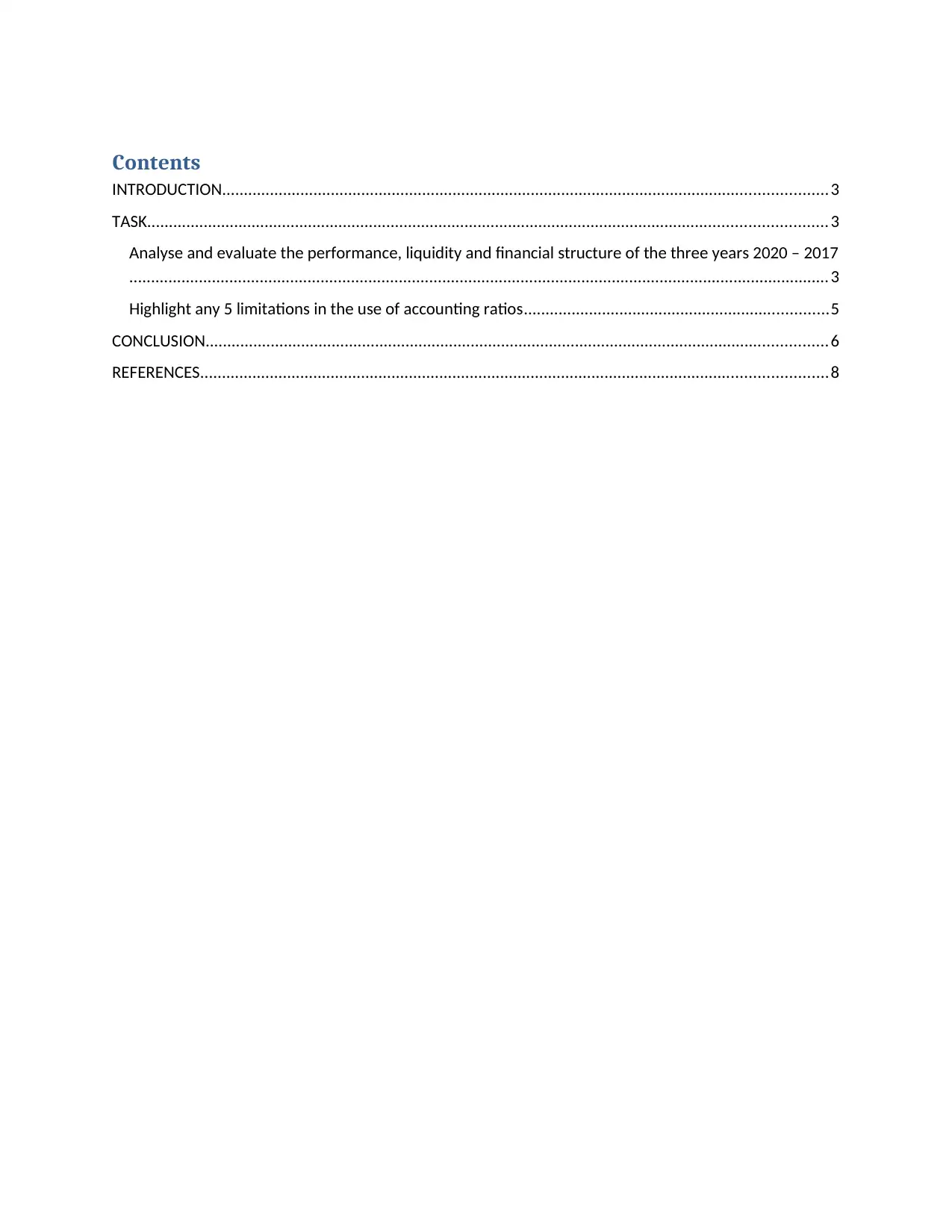
Contents
INTRODUCTION...........................................................................................................................................3
TASK............................................................................................................................................................3
Analyse and evaluate the performance, liquidity and financial structure of the three years 2020 – 2017
.................................................................................................................................................................3
Highlight any 5 limitations in the use of accounting ratios......................................................................5
CONCLUSION...............................................................................................................................................6
REFERENCES................................................................................................................................................8
INTRODUCTION...........................................................................................................................................3
TASK............................................................................................................................................................3
Analyse and evaluate the performance, liquidity and financial structure of the three years 2020 – 2017
.................................................................................................................................................................3
Highlight any 5 limitations in the use of accounting ratios......................................................................5
CONCLUSION...............................................................................................................................................6
REFERENCES................................................................................................................................................8
⊘ This is a preview!⊘
Do you want full access?
Subscribe today to unlock all pages.

Trusted by 1+ million students worldwide

INTRODUCTION
Financial accounting is related with the documentation, summarization, and recording of
company operations that arise as a result of a company's operating procedures. It assists the
company in obtaining consistent readings from business contracts in order to make informed
decisions (Abdelraheem and et.al, 2021). In today's world, there is more rivalry than ever before,
which must be addressed by implementing accurate accounting solutions to achieve
competitiveness. This report based on the Tesco plc. In this report consist of limitations of use of
accounting ratios and interpretation of different ratios.
TASK
Analyse and evaluate the performance, liquidity and financial structure of the three years 2020 –
2017
As from assessment of the profits summary, it must be said that from 2017 to 2020, there is
now volatility. Profitability ratios climbed from 2017 to 2018 and 2019 and that is a good gauge,
however it has diminished in the upcoming term 2020, prompting considerable revisions. If it
concerns to overall revenue, the answer for the setting the parameters is still climbing. The
desired gross profit ratio is assumed to be 10%, which in itself is bigger than TESCO PLC's
actual state. Return on common stockholders play an important role in encouraging an
organization to draw greater funders in terms of enhancing performance ambitions. It was 2.25 %
in 2017, and it climbed to 9.91 percentages in 2020, however it had a negatively sloped
development in 2018 and 2019. It can be established that TESCO PLC should commit to making
significant adjustments depending on the revenue portion of the organization (Kraievskyi and
et.al, 2021).
The operative ratios are used to assess a financial position in attempt to decide it is not
really making the best use of its resources. In a changing scenario, the inventory turnover of net
and fixed assets in during defined period. The asset turnover ratio serves in accessing data
concerning TESCO's performance in refilling goods by transactions. Asset volume has increased
from 24.30 to 26.62 times throughout 2017, demonstrating that the capital adequacy status has
stayed constant. Debtors collection period aids in measuring how an organization gathers
Financial accounting is related with the documentation, summarization, and recording of
company operations that arise as a result of a company's operating procedures. It assists the
company in obtaining consistent readings from business contracts in order to make informed
decisions (Abdelraheem and et.al, 2021). In today's world, there is more rivalry than ever before,
which must be addressed by implementing accurate accounting solutions to achieve
competitiveness. This report based on the Tesco plc. In this report consist of limitations of use of
accounting ratios and interpretation of different ratios.
TASK
Analyse and evaluate the performance, liquidity and financial structure of the three years 2020 –
2017
As from assessment of the profits summary, it must be said that from 2017 to 2020, there is
now volatility. Profitability ratios climbed from 2017 to 2018 and 2019 and that is a good gauge,
however it has diminished in the upcoming term 2020, prompting considerable revisions. If it
concerns to overall revenue, the answer for the setting the parameters is still climbing. The
desired gross profit ratio is assumed to be 10%, which in itself is bigger than TESCO PLC's
actual state. Return on common stockholders play an important role in encouraging an
organization to draw greater funders in terms of enhancing performance ambitions. It was 2.25 %
in 2017, and it climbed to 9.91 percentages in 2020, however it had a negatively sloped
development in 2018 and 2019. It can be established that TESCO PLC should commit to making
significant adjustments depending on the revenue portion of the organization (Kraievskyi and
et.al, 2021).
The operative ratios are used to assess a financial position in attempt to decide it is not
really making the best use of its resources. In a changing scenario, the inventory turnover of net
and fixed assets in during defined period. The asset turnover ratio serves in accessing data
concerning TESCO's performance in refilling goods by transactions. Asset volume has increased
from 24.30 to 26.62 times throughout 2017, demonstrating that the capital adequacy status has
stayed constant. Debtors collection period aids in measuring how an organization gathers
Paraphrase This Document
Need a fresh take? Get an instant paraphrase of this document with our AI Paraphraser
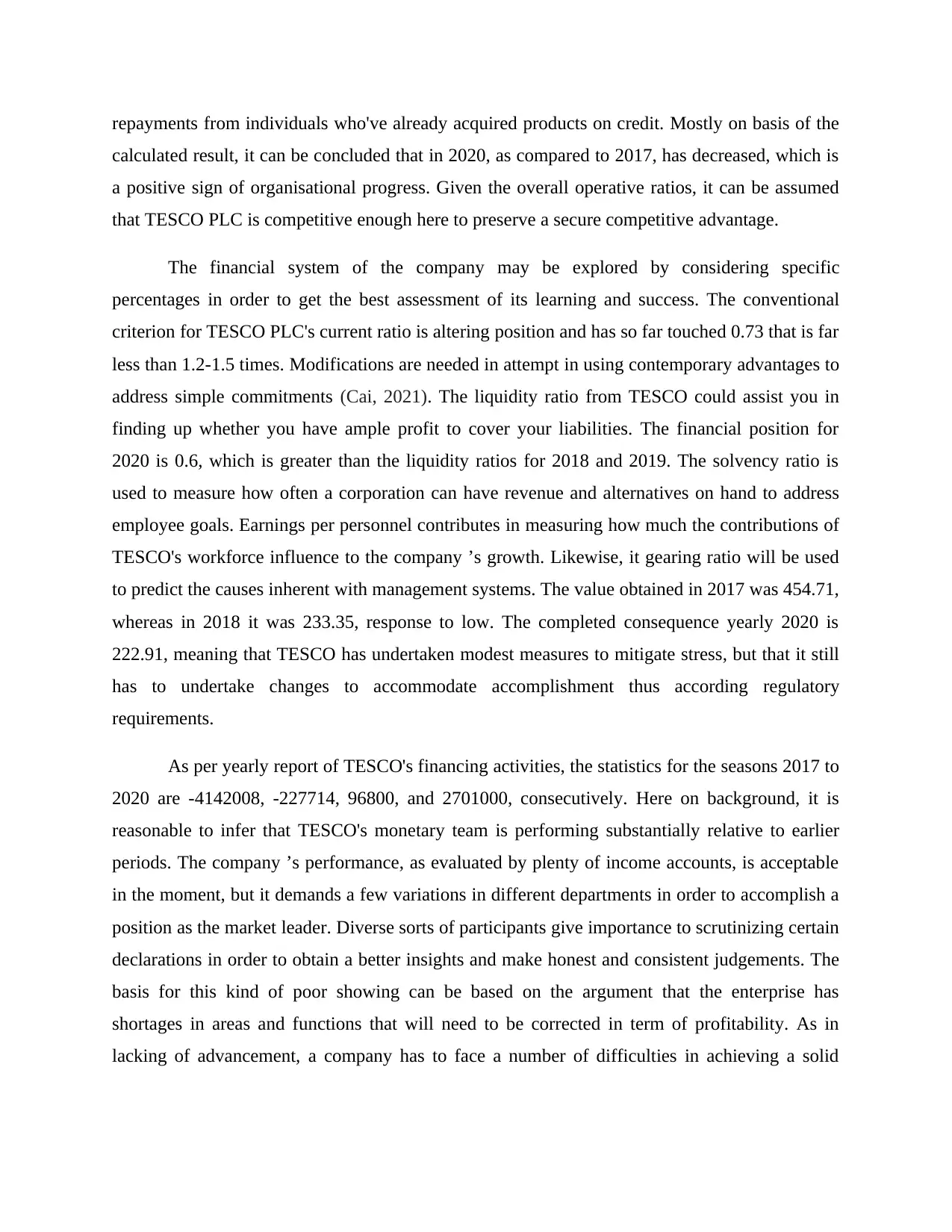
repayments from individuals who've already acquired products on credit. Mostly on basis of the
calculated result, it can be concluded that in 2020, as compared to 2017, has decreased, which is
a positive sign of organisational progress. Given the overall operative ratios, it can be assumed
that TESCO PLC is competitive enough here to preserve a secure competitive advantage.
The financial system of the company may be explored by considering specific
percentages in order to get the best assessment of its learning and success. The conventional
criterion for TESCO PLC's current ratio is altering position and has so far touched 0.73 that is far
less than 1.2-1.5 times. Modifications are needed in attempt in using contemporary advantages to
address simple commitments (Cai, 2021). The liquidity ratio from TESCO could assist you in
finding up whether you have ample profit to cover your liabilities. The financial position for
2020 is 0.6, which is greater than the liquidity ratios for 2018 and 2019. The solvency ratio is
used to measure how often a corporation can have revenue and alternatives on hand to address
employee goals. Earnings per personnel contributes in measuring how much the contributions of
TESCO's workforce influence to the company ’s growth. Likewise, it gearing ratio will be used
to predict the causes inherent with management systems. The value obtained in 2017 was 454.71,
whereas in 2018 it was 233.35, response to low. The completed consequence yearly 2020 is
222.91, meaning that TESCO has undertaken modest measures to mitigate stress, but that it still
has to undertake changes to accommodate accomplishment thus according regulatory
requirements.
As per yearly report of TESCO's financing activities, the statistics for the seasons 2017 to
2020 are -4142008, -227714, 96800, and 2701000, consecutively. Here on background, it is
reasonable to infer that TESCO's monetary team is performing substantially relative to earlier
periods. The company ’s performance, as evaluated by plenty of income accounts, is acceptable
in the moment, but it demands a few variations in different departments in order to accomplish a
position as the market leader. Diverse sorts of participants give importance to scrutinizing certain
declarations in order to obtain a better insights and make honest and consistent judgements. The
basis for this kind of poor showing can be based on the argument that the enterprise has
shortages in areas and functions that will need to be corrected in term of profitability. As in
lacking of advancement, a company has to face a number of difficulties in achieving a solid
calculated result, it can be concluded that in 2020, as compared to 2017, has decreased, which is
a positive sign of organisational progress. Given the overall operative ratios, it can be assumed
that TESCO PLC is competitive enough here to preserve a secure competitive advantage.
The financial system of the company may be explored by considering specific
percentages in order to get the best assessment of its learning and success. The conventional
criterion for TESCO PLC's current ratio is altering position and has so far touched 0.73 that is far
less than 1.2-1.5 times. Modifications are needed in attempt in using contemporary advantages to
address simple commitments (Cai, 2021). The liquidity ratio from TESCO could assist you in
finding up whether you have ample profit to cover your liabilities. The financial position for
2020 is 0.6, which is greater than the liquidity ratios for 2018 and 2019. The solvency ratio is
used to measure how often a corporation can have revenue and alternatives on hand to address
employee goals. Earnings per personnel contributes in measuring how much the contributions of
TESCO's workforce influence to the company ’s growth. Likewise, it gearing ratio will be used
to predict the causes inherent with management systems. The value obtained in 2017 was 454.71,
whereas in 2018 it was 233.35, response to low. The completed consequence yearly 2020 is
222.91, meaning that TESCO has undertaken modest measures to mitigate stress, but that it still
has to undertake changes to accommodate accomplishment thus according regulatory
requirements.
As per yearly report of TESCO's financing activities, the statistics for the seasons 2017 to
2020 are -4142008, -227714, 96800, and 2701000, consecutively. Here on background, it is
reasonable to infer that TESCO's monetary team is performing substantially relative to earlier
periods. The company ’s performance, as evaluated by plenty of income accounts, is acceptable
in the moment, but it demands a few variations in different departments in order to accomplish a
position as the market leader. Diverse sorts of participants give importance to scrutinizing certain
declarations in order to obtain a better insights and make honest and consistent judgements. The
basis for this kind of poor showing can be based on the argument that the enterprise has
shortages in areas and functions that will need to be corrected in term of profitability. As in
lacking of advancement, a company has to face a number of difficulties in achieving a solid
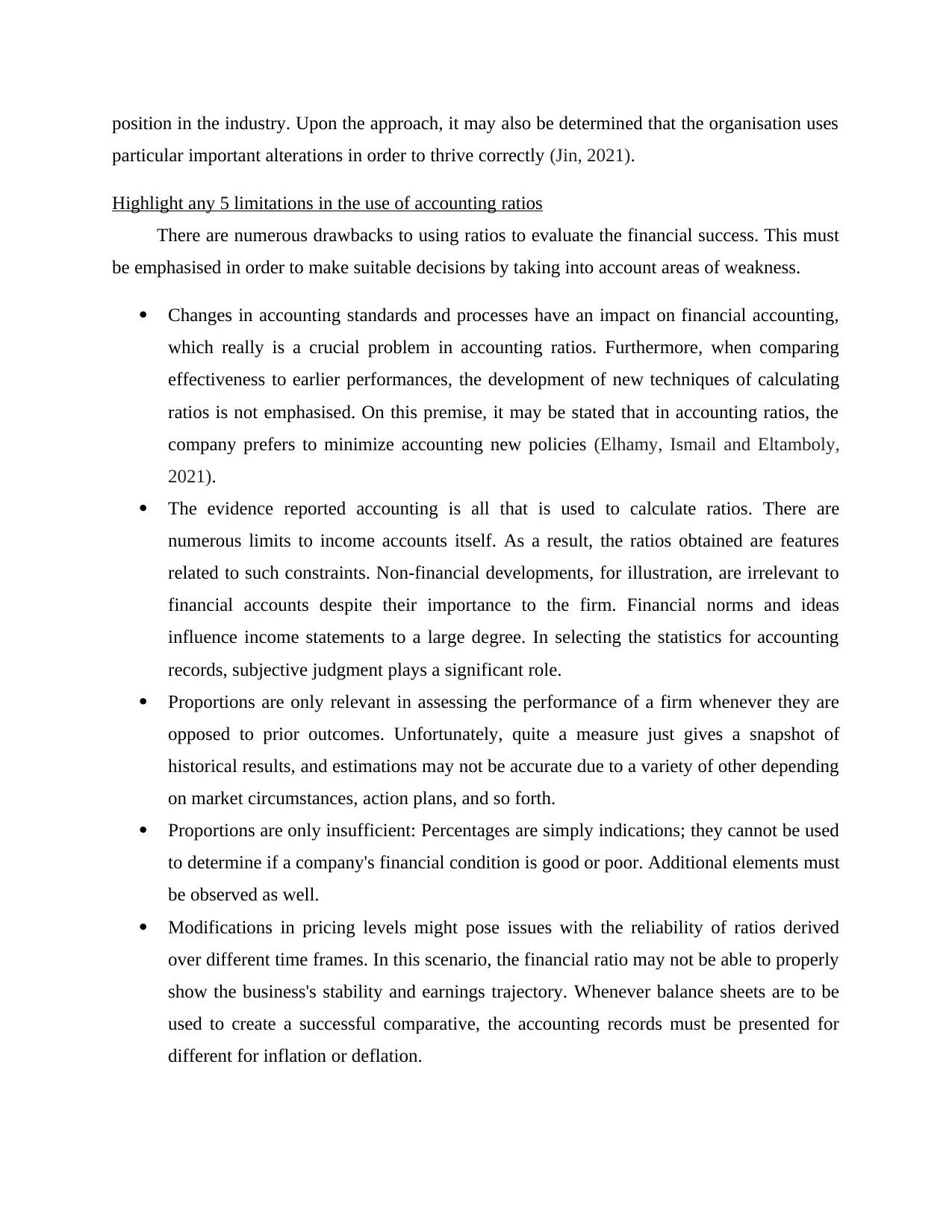
position in the industry. Upon the approach, it may also be determined that the organisation uses
particular important alterations in order to thrive correctly (Jin, 2021).
Highlight any 5 limitations in the use of accounting ratios
There are numerous drawbacks to using ratios to evaluate the financial success. This must
be emphasised in order to make suitable decisions by taking into account areas of weakness.
Changes in accounting standards and processes have an impact on financial accounting,
which really is a crucial problem in accounting ratios. Furthermore, when comparing
effectiveness to earlier performances, the development of new techniques of calculating
ratios is not emphasised. On this premise, it may be stated that in accounting ratios, the
company prefers to minimize accounting new policies (Elhamy, Ismail and Eltamboly,
2021).
The evidence reported accounting is all that is used to calculate ratios. There are
numerous limits to income accounts itself. As a result, the ratios obtained are features
related to such constraints. Non-financial developments, for illustration, are irrelevant to
financial accounts despite their importance to the firm. Financial norms and ideas
influence income statements to a large degree. In selecting the statistics for accounting
records, subjective judgment plays a significant role.
Proportions are only relevant in assessing the performance of a firm whenever they are
opposed to prior outcomes. Unfortunately, quite a measure just gives a snapshot of
historical results, and estimations may not be accurate due to a variety of other depending
on market circumstances, action plans, and so forth.
Proportions are only insufficient: Percentages are simply indications; they cannot be used
to determine if a company's financial condition is good or poor. Additional elements must
be observed as well.
Modifications in pricing levels might pose issues with the reliability of ratios derived
over different time frames. In this scenario, the financial ratio may not be able to properly
show the business's stability and earnings trajectory. Whenever balance sheets are to be
used to create a successful comparative, the accounting records must be presented for
different for inflation or deflation.
particular important alterations in order to thrive correctly (Jin, 2021).
Highlight any 5 limitations in the use of accounting ratios
There are numerous drawbacks to using ratios to evaluate the financial success. This must
be emphasised in order to make suitable decisions by taking into account areas of weakness.
Changes in accounting standards and processes have an impact on financial accounting,
which really is a crucial problem in accounting ratios. Furthermore, when comparing
effectiveness to earlier performances, the development of new techniques of calculating
ratios is not emphasised. On this premise, it may be stated that in accounting ratios, the
company prefers to minimize accounting new policies (Elhamy, Ismail and Eltamboly,
2021).
The evidence reported accounting is all that is used to calculate ratios. There are
numerous limits to income accounts itself. As a result, the ratios obtained are features
related to such constraints. Non-financial developments, for illustration, are irrelevant to
financial accounts despite their importance to the firm. Financial norms and ideas
influence income statements to a large degree. In selecting the statistics for accounting
records, subjective judgment plays a significant role.
Proportions are only relevant in assessing the performance of a firm whenever they are
opposed to prior outcomes. Unfortunately, quite a measure just gives a snapshot of
historical results, and estimations may not be accurate due to a variety of other depending
on market circumstances, action plans, and so forth.
Proportions are only insufficient: Percentages are simply indications; they cannot be used
to determine if a company's financial condition is good or poor. Additional elements must
be observed as well.
Modifications in pricing levels might pose issues with the reliability of ratios derived
over different time frames. In this scenario, the financial ratio may not be able to properly
show the business's stability and earnings trajectory. Whenever balance sheets are to be
used to create a successful comparative, the accounting records must be presented for
different for inflation or deflation.
⊘ This is a preview!⊘
Do you want full access?
Subscribe today to unlock all pages.

Trusted by 1+ million students worldwide
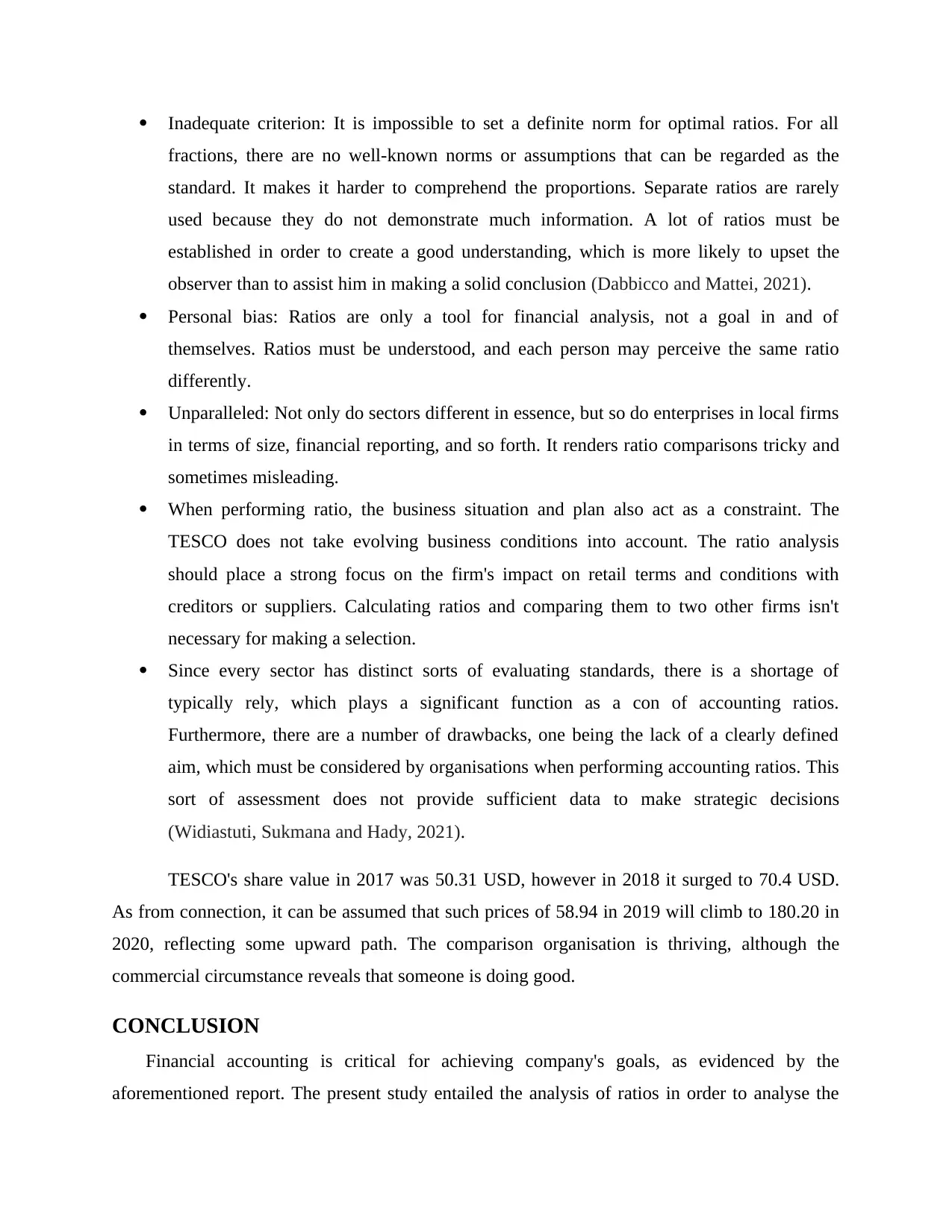
Inadequate criterion: It is impossible to set a definite norm for optimal ratios. For all
fractions, there are no well-known norms or assumptions that can be regarded as the
standard. It makes it harder to comprehend the proportions. Separate ratios are rarely
used because they do not demonstrate much information. A lot of ratios must be
established in order to create a good understanding, which is more likely to upset the
observer than to assist him in making a solid conclusion (Dabbicco and Mattei, 2021).
Personal bias: Ratios are only a tool for financial analysis, not a goal in and of
themselves. Ratios must be understood, and each person may perceive the same ratio
differently.
Unparalleled: Not only do sectors different in essence, but so do enterprises in local firms
in terms of size, financial reporting, and so forth. It renders ratio comparisons tricky and
sometimes misleading.
When performing ratio, the business situation and plan also act as a constraint. The
TESCO does not take evolving business conditions into account. The ratio analysis
should place a strong focus on the firm's impact on retail terms and conditions with
creditors or suppliers. Calculating ratios and comparing them to two other firms isn't
necessary for making a selection.
Since every sector has distinct sorts of evaluating standards, there is a shortage of
typically rely, which plays a significant function as a con of accounting ratios.
Furthermore, there are a number of drawbacks, one being the lack of a clearly defined
aim, which must be considered by organisations when performing accounting ratios. This
sort of assessment does not provide sufficient data to make strategic decisions
(Widiastuti, Sukmana and Hady, 2021).
TESCO's share value in 2017 was 50.31 USD, however in 2018 it surged to 70.4 USD.
As from connection, it can be assumed that such prices of 58.94 in 2019 will climb to 180.20 in
2020, reflecting some upward path. The comparison organisation is thriving, although the
commercial circumstance reveals that someone is doing good.
CONCLUSION
Financial accounting is critical for achieving company's goals, as evidenced by the
aforementioned report. The present study entailed the analysis of ratios in order to analyse the
fractions, there are no well-known norms or assumptions that can be regarded as the
standard. It makes it harder to comprehend the proportions. Separate ratios are rarely
used because they do not demonstrate much information. A lot of ratios must be
established in order to create a good understanding, which is more likely to upset the
observer than to assist him in making a solid conclusion (Dabbicco and Mattei, 2021).
Personal bias: Ratios are only a tool for financial analysis, not a goal in and of
themselves. Ratios must be understood, and each person may perceive the same ratio
differently.
Unparalleled: Not only do sectors different in essence, but so do enterprises in local firms
in terms of size, financial reporting, and so forth. It renders ratio comparisons tricky and
sometimes misleading.
When performing ratio, the business situation and plan also act as a constraint. The
TESCO does not take evolving business conditions into account. The ratio analysis
should place a strong focus on the firm's impact on retail terms and conditions with
creditors or suppliers. Calculating ratios and comparing them to two other firms isn't
necessary for making a selection.
Since every sector has distinct sorts of evaluating standards, there is a shortage of
typically rely, which plays a significant function as a con of accounting ratios.
Furthermore, there are a number of drawbacks, one being the lack of a clearly defined
aim, which must be considered by organisations when performing accounting ratios. This
sort of assessment does not provide sufficient data to make strategic decisions
(Widiastuti, Sukmana and Hady, 2021).
TESCO's share value in 2017 was 50.31 USD, however in 2018 it surged to 70.4 USD.
As from connection, it can be assumed that such prices of 58.94 in 2019 will climb to 180.20 in
2020, reflecting some upward path. The comparison organisation is thriving, although the
commercial circumstance reveals that someone is doing good.
CONCLUSION
Financial accounting is critical for achieving company's goals, as evidenced by the
aforementioned report. The present study entailed the analysis of ratios in order to analyse the
Paraphrase This Document
Need a fresh take? Get an instant paraphrase of this document with our AI Paraphraser

business results of a certain business, indicating that the corporate accounting condition is bad.
Statistical information, shifting accounting methods, a lack of acceptable standards, the
avoidance of external forces, and a biased viewpoint are among the shortcomings found by the
evaluation, all of which generate incorrect conclusions.
Statistical information, shifting accounting methods, a lack of acceptable standards, the
avoidance of external forces, and a biased viewpoint are among the shortcomings found by the
evaluation, all of which generate incorrect conclusions.
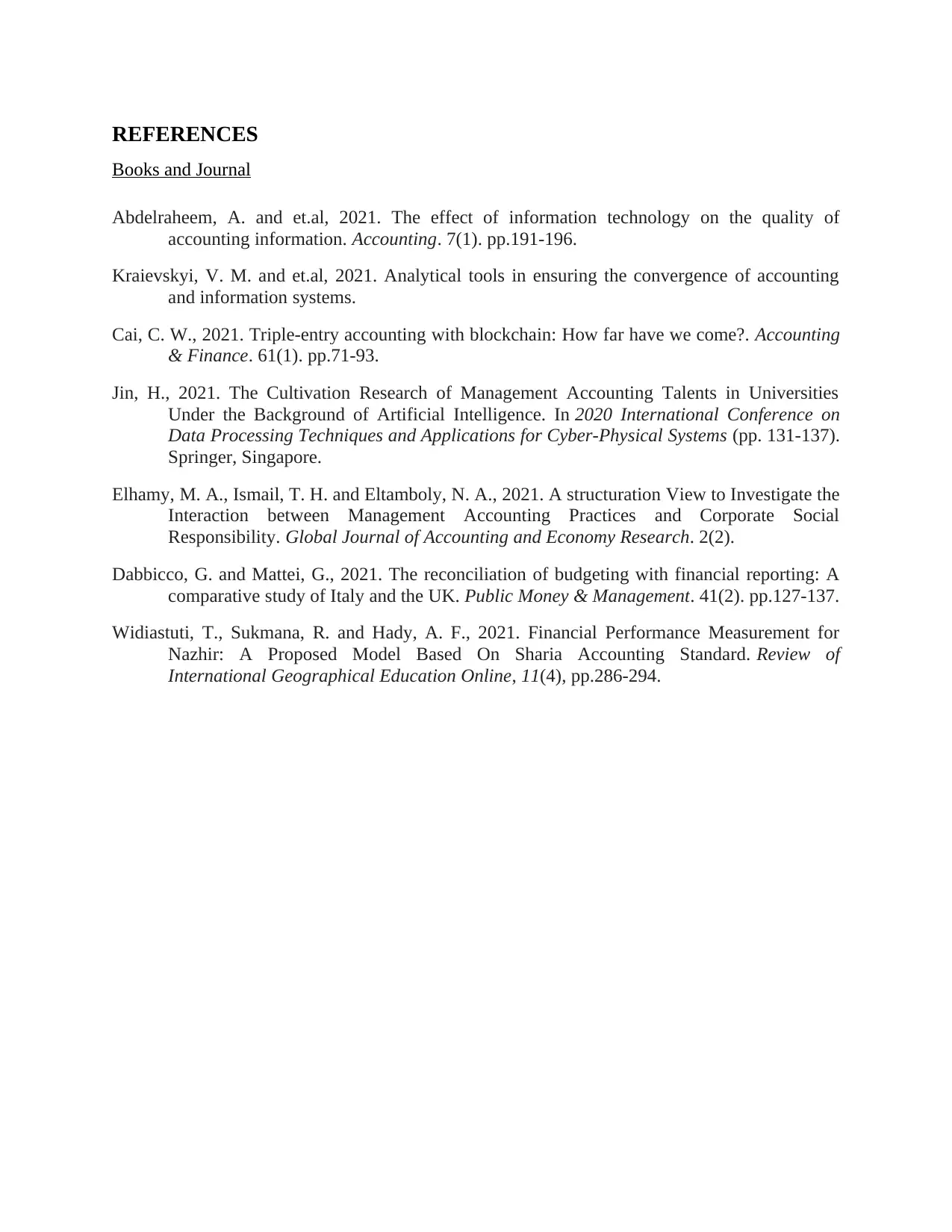
REFERENCES
Books and Journal
Abdelraheem, A. and et.al, 2021. The effect of information technology on the quality of
accounting information. Accounting. 7(1). pp.191-196.
Kraievskyi, V. M. and et.al, 2021. Аnalytical tools in ensuring the convergence of accounting
and information systems.
Cai, C. W., 2021. Triple‐entry accounting with blockchain: How far have we come?. Accounting
& Finance. 61(1). pp.71-93.
Jin, H., 2021. The Cultivation Research of Management Accounting Talents in Universities
Under the Background of Artificial Intelligence. In 2020 International Conference on
Data Processing Techniques and Applications for Cyber-Physical Systems (pp. 131-137).
Springer, Singapore.
Elhamy, M. A., Ismail, T. H. and Eltamboly, N. A., 2021. A structuration View to Investigate the
Interaction between Management Accounting Practices and Corporate Social
Responsibility. Global Journal of Accounting and Economy Research. 2(2).
Dabbicco, G. and Mattei, G., 2021. The reconciliation of budgeting with financial reporting: A
comparative study of Italy and the UK. Public Money & Management. 41(2). pp.127-137.
Widiastuti, T., Sukmana, R. and Hady, A. F., 2021. Financial Performance Measurement for
Nazhir: A Proposed Model Based On Sharia Accounting Standard. Review of
International Geographical Education Online, 11(4), pp.286-294.
Books and Journal
Abdelraheem, A. and et.al, 2021. The effect of information technology on the quality of
accounting information. Accounting. 7(1). pp.191-196.
Kraievskyi, V. M. and et.al, 2021. Аnalytical tools in ensuring the convergence of accounting
and information systems.
Cai, C. W., 2021. Triple‐entry accounting with blockchain: How far have we come?. Accounting
& Finance. 61(1). pp.71-93.
Jin, H., 2021. The Cultivation Research of Management Accounting Talents in Universities
Under the Background of Artificial Intelligence. In 2020 International Conference on
Data Processing Techniques and Applications for Cyber-Physical Systems (pp. 131-137).
Springer, Singapore.
Elhamy, M. A., Ismail, T. H. and Eltamboly, N. A., 2021. A structuration View to Investigate the
Interaction between Management Accounting Practices and Corporate Social
Responsibility. Global Journal of Accounting and Economy Research. 2(2).
Dabbicco, G. and Mattei, G., 2021. The reconciliation of budgeting with financial reporting: A
comparative study of Italy and the UK. Public Money & Management. 41(2). pp.127-137.
Widiastuti, T., Sukmana, R. and Hady, A. F., 2021. Financial Performance Measurement for
Nazhir: A Proposed Model Based On Sharia Accounting Standard. Review of
International Geographical Education Online, 11(4), pp.286-294.
⊘ This is a preview!⊘
Do you want full access?
Subscribe today to unlock all pages.

Trusted by 1+ million students worldwide
1 out of 9
Related Documents
Your All-in-One AI-Powered Toolkit for Academic Success.
+13062052269
info@desklib.com
Available 24*7 on WhatsApp / Email
![[object Object]](/_next/static/media/star-bottom.7253800d.svg)
Unlock your academic potential
© 2024 | Zucol Services PVT LTD | All rights reserved.




